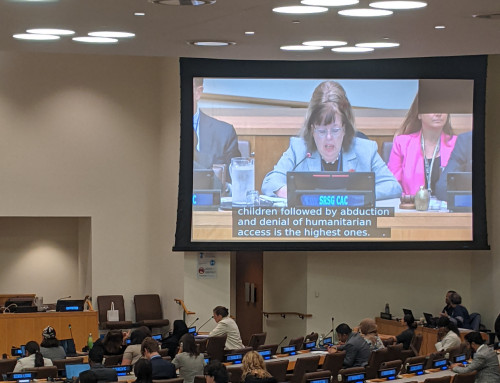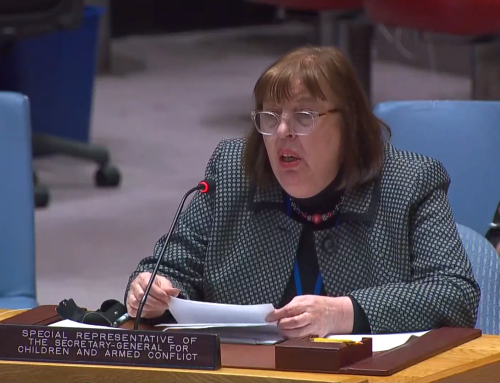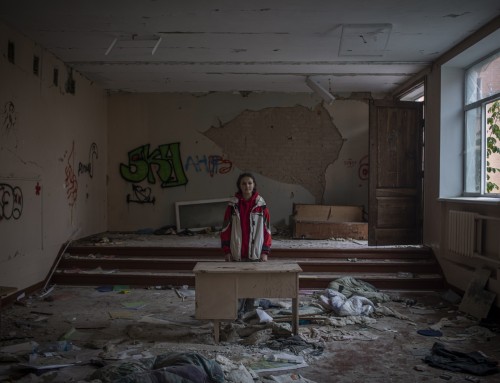Mr. President, Excellencies, ladies and gentlemen
The year 2011 continued to be a devastating year for children in situations of armed conflict, although some progress was observed. Among the successes was the action taken by the Security Council in July 2011 to make attacks on schools and hospitals a trigger for listing of Parties to conflict in the annexes of the Secretary-General’s Annual Report on Children and Armed Conflict. By calling on the Secretary-General to name parties that attack schools and hospitals and put children at risk, the Council recognized the importance of these institutions, essential for children, and the need to make them areas of safety during armed conflict. Schools in particular must be zones of peace where children receive protection and are allowed to continue with their education regardless of the conflict. Child protection partners around the world have insisted that the right to education be an important part of emergency response and that schooling must continue even in emergency situations.
Some important successes were also achieved in the field, where the United Nations facilitated, since previous report to the Human Rights Council, the release of over 10,000 children associated with armed forces and armed groups. Commitments made by the Unified Communist Party of Nepal-Maoist, the Moro Islamic Liberation Front in the Philippines, and the Sudan People’s Liberation Army have been translated into concrete actions by these parties. Efforts on the ground also ensured the release of children in the Central African Republic, DRC, Myanmar and Sri Lanka. New Action Plans to cease the recruitment of children as well as to secure their release were signed by the United Nations and the Government of Afghanistan on 30 January 2011; and the Chadian National Forces on 16 June 2011. I personally witnessed these agreements. The durable separation of children from armed forces and groups is a complex process that requires support from child protection partners and the provision of reintegration opportunities focusing on both education and livelihood skills. Reintegration assistance must be tailored to the specific needs of children, if we want it to be successful and prevent relapse.
Last month I attended the closing statements in the Lubanga case before the International Criminal Court. Thomas Lubanga is a former warlord from eastern DRC who is accused of recruiting and using child soldiers in the Ituri conflict from 2002 to 2003. This is the ICC’s first trial and will likely be the first to be completed by the world’s only permanent court mandated to try war crimes. It will also be the first case that sets out international jurisprudence on the crime of recruiting child soldiers. This case is a crucial step in ending impunity for violations against children during armed conflict. It sends a clear message to commanders that child recruitment is a war crime under the Rome Statute and will be prosecuted. It is also creating attitudinal change in national courts, which are now increasingly prosecuting such crimes and thus preventing and deterring violations against children. In many of my negotiations with non-state armed groups for the release of children, my interlocutors have questioned me in detail about the ICC’s work. There is some fear about the ICC and this fear is healthy. Hopefully, the possibility of appearing before the ICC will serve as a deterrent against child recruitment in places where an armed conflict is occurring. To be truly effective, however, action must be taken at the national level.
Another interesting development is the fact that prominent religious leaders are responding to the concerns of children in armed conflict by taking a public stance against acts of violence against children. In Afghanistan, for example, the Ulema Shura, with whom we have a continuing dialogue, proclaimed a fatwa in March 2011, asking to halt the recruitment and use of children in armed forces and armed groups, and requesting the Government to ensure education for these children and to provide their families with assistance to meet their basic needs. They also condemned in the strongest terms the killing of innocent civilians, including women, children and elderly, and the use of suicide attacks as a combat tactic. Faith communities are essential in the struggle to prevent the recruitment and use of children, and in the long process of helping child victims to recover from traumatic war experiences. They play an important role in protecting children in times of war by informing parents and children about the dangers of recruitment, providing safe spaces during armed conflict and offering valuable spiritual and psychosocial support.
Despite these developments, many challenges remain. New instruments of war, including the use of new technologies, the absence of clear battlefields and identifiable opponents have led to greater risks to children during military operations. Child casualties during ongoing military operations remain an issue of serious concern to my Office. Whether in Afghanistan, Libya or Pakistan – wherever aerial attacks and drone operations occur – the technological potential to kill civilians, including children, may result in devastating circumstances. We recognize that such attacks are not prohibited by international humanitarian law, as long as the principles of distinction and proportionality are upheld. However, standard operating procedures must exist to minimize civilian casualties. If casualties are high, such attacks should be abandoned or other appropriate avenues for conducting operations should be pursued. Too many children have been killed by aerial attacks and falling bombs during the past year, and we must try to ensure that next year will result in zero child casualties.
Another growing concern, characteristic of the changing nature of armed conflict, is the use of children as suicide bombers. Throughout the year, in different countries, we have witnessed an increase in the use of child suicide bombers and child victim bombers, those who do not even know they are carrying explosives and who are detonated from a distance. It goes without saying that a more cruel act is hard to fathom. The use of girls’ and boys’ bodies as bombs of destruction must be one of the most perverse developments in modern warfare. Denying children the right to life in such a horrific manner defies all existing moral norms. We urge for a universal outcry on this issue, across regions, religions and national boundaries. We urge those who have any influence to encourage groups to stop this abominable practice and to return children to their families. Nobody can stand by and allow this practice to grow – it is on all our consciences.
Another new challenge we face is the detention and prosecution of children in situations of armed conflict. States are increasingly arresting and detaining children associated with armed groups, be it because they are a threat to national security or because they have participated in hostilities. Children who are captured and placed in detention are sometimes kept in conditions which do not meet the minimum standards set out in various international legal instruments.
In some situations, States place children in administrative detention, rather than charging them with a criminal offence and bringing them before a Court. These children are often detained for long periods of time without being granted access to a lawyer or other legal safeguards. Evidence abounds that, when deprived of their liberty, children are particularly vulnerable to human rights abuses.
In other situations, States prosecute children for acts committed while associated with an armed group. National courts and military tribunals, however, do not generally apply juvenile standards. As a result, these children are frequently tried without legal representation or assistance, are not accompanied by their parents and often do not possess a clear understanding of the charges brought against them.
Given the forced nature of their association with armed groups, and considering their age, children should be treated primarily as victims, not as perpetrators. Emphasis should be placed on prosecuting adult recruiters and commanders based on the concept of command responsibility. The detention and prosecution of children for crimes arising from their active participation in hostilities should always be a measure of last resort. Many children may themselves have been forced or enticed to join an armed group. In addition, during their association, children are often abused, beaten, exploited and manipulated by commanders to commit criminal acts.
The need for some form of accountability is acknowledged, children must be made to face the consequences of their actions and victims of their violence must feel that justice has been done. Nevertheless diversion away from the judicial system is more suitable for children and the society as a whole. Alternatives that take the best interest of the child into consideration and promote the reintegration of the child into his or her community include non-judicial mechanisms, such as restorative justice measures, truth-telling, traditional healing ceremonies and reintegration programmes.
Our Office has prepared a working paper on children and justice, which we are launching at this session of the Human Rights Council. This publication further explores the issue of accountability of children who have committed criminal acts during armed conflict and alternatives that can be used to assist children in reintegrating into society. We feel this Council is the most appropriate forum to deal with these human rights issues.
Mr. President,
While it is the main task of my Office to try and end grave violations against children, the international community and national Governments must have the resources to help children who are victims of violations to begin a new life. In an era of austerity this requires special attention by donor communities and Governments. Mr. President, let me also pay tribute to the Child Protection Officers of UNICEF and Child Protection Advisors of DPKO, who are in the field every day doing work for all of us. They live dangerous lives, often going alone to negotiate with warlords and rebel groups to release children and stop violations against children. They lead lives of hardship in some of the most remote places of the world. They are the unsung heroes of our institution. Many children, who have now grown into adults, in places like Gulu, Uganda, wept and through me thanked the United Nations for sending these child protection teams who with other partners try to create a humane safety net in situations of armed conflict. It is important once in a while to recognize their work and give them encouragement and resources. They are often the only reminder in communities in conflict that the world has not forgotten them.
Finally, Mr. President,
Let me end by going back to my fist point and remember Fatima, who I recently met in eastern Chad at a refugee camp. Her family had lost everything. Her eldest sister was abducted and taken away for a forced marriage, a terrible practice in some parts of Chad. She held my hand tightly and asked for a secondary school in the refugee camp. She wanted to study to become a teacher. We must not forget Fatima and children like her around the world. We must protect girls and we must protect schools. This is their future.
Thank you, Mr. President.





